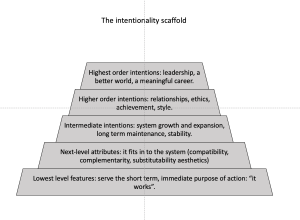The Value Creators Podcast Episode #62. Choose the Handle That Holds. Stoic Leadership and Everyday Integrity: A Conversation with Becky Schmooke
Listen to the episode here:
How we lead is who we are.
In this episode of the Value Creators Podcast, Hunter Hastings speaks with Becky Schmooke—entrepreneur, leadership coach, and author of Choose the Handle That Holds. Becky shares how the system of philosophy we label as Stoic generates practical tools for leadership, self-awareness, and resilience. Rather than hierarchical leadership vested with titles and administrative control, Becky proposes a more human vision of leadership: grounded in personal values, emotional clarity, and active participation.
Key themes include:
- Why authority and leadership are not the same—and how leadership is a lifestyle, not a position.
- How Stoicism reframes control, responsibility, and purpose in business and life.
- What it means to “choose the handle that holds”—and how to build emotional intelligence through action, not theory.
This conversation is a guide for anyone who wants to lead with clarity, build resilient organizations, and live aligned with their deepest values.
Resources:
➡️ Learn What They Didn’t Teach You In Business School: The Value Creators Online Business Course
Buy Becky’s book: Choose The Handle That Holds
Learn more about Becky Schmooke
Connect with Becky Schmooke on LinkedIn
Connect with Hunter Hastings on LinkedIn
Subscribe to The Value Creators on Substack
Knowledge Capsule:
1. Leadership is Who You Are, Not your position or title
- Leadership is often misdefined as authority or power tied to position.
- True leadership is available to everyone, regardless of rank or role.
- It’s who you are and how you turn up every day
- Great leaders are also great followers—engaged, empathetic, and collaborative.
2. Teams Should Be Made of Leaders
- Hierarchical models miss the value of shared leadership and active participation.
- Individuals in high-performing teams, like Olympic athletes, take turns leading based on context.
- “Followership” is powerful when it means knowing when to support and when to step up.
3. Choose the Handle That Holds
- As described by the stoic philosopher Epictetus, each situation has two “handles”—ways to approach it.
- The “handle that holds” is integrity, courage, and ownership—not blame or denial.
- Leaders who choose the right handle foster resilience and long-term trust.
4. Integrity Requires Personal Definition
- Integrity isn’t one-size-fits-all; it depends on your individual values.
- Defining what matters helps guide decision-making under pressure.
- Businesses without this clarity often chase hollow definitions of success.
5. The Four Stoic Virtues are Practical Anchors
- Wisdom, courage, justice, and temperance shape steady, resilient action.
- These values ground behavior and decision-making amid external chaos.
- For example, temperance (moderation) keeps us focused on long-term process over short-term wins.
6. Values-Driven Business Builds Market Trust
- Living your values builds credibility with customers, employees, and partners.
- Consumers reward integrity and are more forgiving of missteps when trust is earned.
- Purposeful entrepreneurs create subjective value that the market recognizes.
7. Control is Internal, Not External
- Stoicism teaches us to distinguish between what we can and cannot control.
- In business, focusing too much on outcomes breeds anxiety and inefficiency.
- Small, consistent actions aligned with values are more impactful than rigid plans.
8. Planning Must Be Flexible and Purpose-Driven
- Plans aren’t inherently bad, but rigid ones can trap organizations.
- Stoic-inspired planning involves adaptation, feedback, and clear purpose.
- The real test is knowing when to stay the course—and when to shift it.
9. Purpose Should Anchor Personal and Business Life
- Individual purpose must be discovered and aligned with everyday actions.
- Companies can also have purpose—if it’s lived, not just printed on a wall.
- Purpose sustains integrity under pressure and fuels long-term innovation.
10. Hierarchies Can Work—If Culture is Right
- Flat organizations are inspiring but hard to scale; hierarchy isn’t inherently bad.
- What matters is cultural leadership at every level—ownership, not obedience.
- Debriefs, shared accountability, and transparency help flatten behaviorally, if not structurally.
11. Stoicism is Emotional, Not Emotionless
- Big-S Stoicism engages deeply with emotions—it doesn’t suppress them.
- Emotions are data; curiosity is the default reflex for emotional intelligence.
- A “leadership reflex” (like the parenting car-arm) pauses reaction and invites insight.
12. Unshakable Purpose is the Supreme Aspiration
- Seneca said it best: our longing is to be “not shaken” by events.
- That inner steadiness is the outcome of living Stoic values every day.
- Leaders who cultivate this internal strength create enduring impact in uncertain environments.
